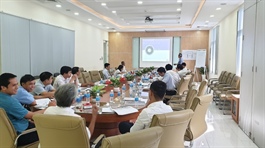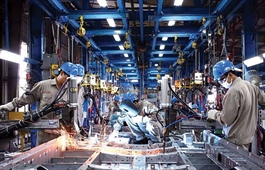Vietnam-RoK agreement minimizes origin pressure on exports to EU
Vietnam-RoK agreement minimizes origin pressure on exports to EU
The agreement on cumulation of origin of textile materials signed by Vietnam and the Republic of Korea (RoK) is helping Vietnamese textile and garment enterprises take advantage of tariff preferences offered by the EU-Vietnam Free Trade Agreement (EVFTA).

The Vietnam-RoK agreement on cumulation of origin of textile materials helps ease origin-related pressure on domestic textile and garment enterprises
|
Concern over dual rules of origin
Under the EVFTA commitments, Vietnamese business must satisfy strict rules of origin, in addition to meeting strict quality criteria, to enjoy preferential tariffs. Specifically, exports to the EU must be produced with fabric made in Vietnam or the EU or third countries that have signed an FTA with the EU, such as the RoK and Japan.
Sixty percent of Garment 10 Corporation’s exports are sold to the EU, with most exports to the EU manufactured according to partners’ orders, but the corporation imports fabrics from China and Chinese Taipei, which are not eligible for the EVFTA incentives.
A large number of textile and garment businesses have a similar problem. Since the price of Chinese materials is attractive, Vietnamese textile and garment companies import 60 percent of materials they need from China. This explains why the amount of Vietnamese textile and garment exports benefiting from EVFTA incentives remains modest.
Investment in upstream development in order to manufacture raw materials is crucial for the textile and garment industry to take advantage of FTA incentives. However, according to Le Tien Truong, Board Chair of the Vietnam National Textile and Garment Group (VINATEX), this is a real challenge given the small size of most Vietnamese garment and textile firms. A factory manufacturing 10 million meters of fabric annually is valued at about VND700 billion, while 85 percent of Vietnamese textile and garment businesses have capital of less than VND50 billion, 15 percent of them have capital of more than VND50 billion, and only three percent have VND500 billion each, Truong said.

The textile and garment industry is one of the first to benefit from the EVFTA so far
|
Reducing origin pressure
The worry about EVFTA-related fabric origin rules has been somewhat eased since Vietnam and the RoK signed an agreement on implementation of cumulation of origin of textile materials in December 2020. According to Truong, the agreement will increase the rate of Vietnamese textile and garment exports meeting EVFTA origin rules since domestic companies will consider increasing the use of Korean fabrics to meet EVFTA rules of origin, Truong said.
Truong suggested that the Ministry of Industry and Trade immediately consider implementation of cumulation of origin of textile materials with Japan, another country that has signed an FTA with the EU. The RoK and Japan account for 23 percent of Vietnam’s fabric import value. Specifically, the RoK exported fabrics worth US$2 billion and Japan more than US$800 million to Vietnam, accounting for 16 and 7 percent of the country’s fabric import value, respectively.
In the long term, foreign investment in fabric production is vital. Specifically, the government should have a plan to develop large enough industrial parks with adequate wastewater treatment infrastructure for textile and garment material production, free domestic enterprises buying textile and garment materials from paying value added tax (VAT), and reduce logistics rates.
Meanwhile, businesses need to take the initiative in approaching EU customers to attract more orders, and look for domestic providers of fabrics as substitutes for imports.



























